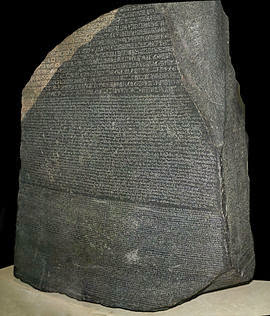The stone was discovered in 1799 by a soldier in Napoleon's army. When Napoleon went on campaign in Egypt he brought scientists with him, and they recognized the importance of this find. The stone had an inscription written in three languages: Egyptian Hieroglyphics, Demotic Text (also called "ancient cursive Coptic"), and Ancient Greek. The Ancient Greek language was known (in fact until a couple of decades ago any truly educated person learned Ancient Greek and also Latin). The fact that these three languages were expressing the same decree and that one of them was well-understood became the key to unlocking knowledge and understanding that had been lost for more than a thousand years.
Here is the stone, which is now housed in the British Museum in London:
And here I am looking at the stone in 2003 when I had opportunity to travel to England. Of all the things in London that there were to see, this was definitely on my "Top Ten" list!
POST SCRIPT: Since that 2003 trip I have taken an additional trip to London in 2016, and I went back to see the Rosetta Stone again, because it's just that awesome. Here are some pictures a bit closer up:




